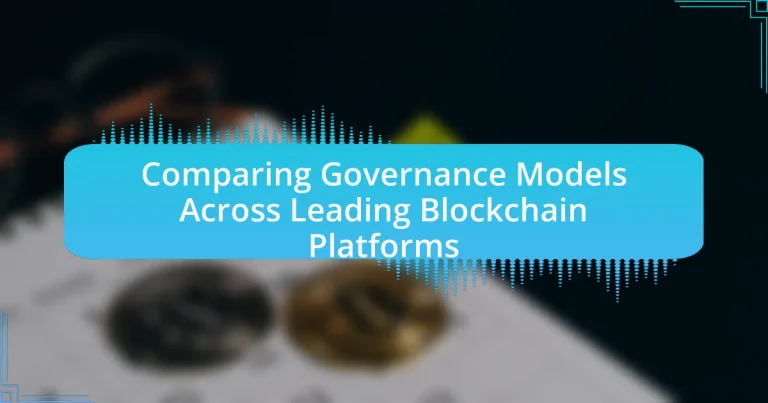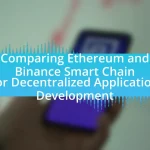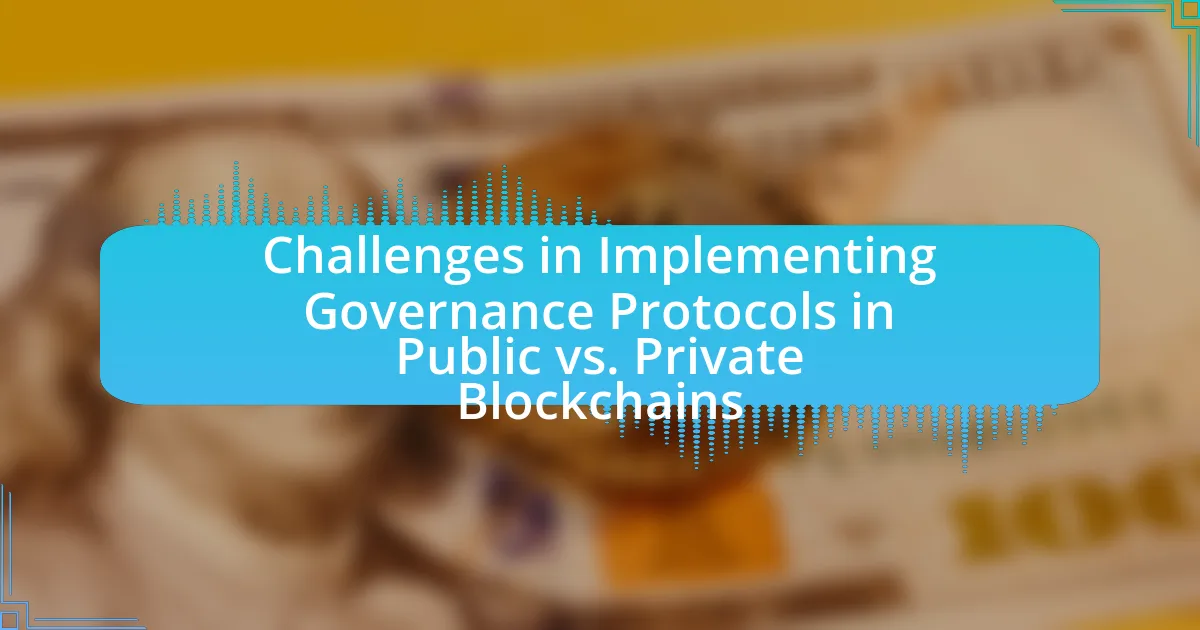The article focuses on comparing governance models across leading blockchain platforms, specifically examining on-chain, off-chain, and hybrid governance structures. It outlines how these models influence decision-making processes, community participation, and the overall adaptability of blockchain networks. Key components such as consensus mechanisms, stakeholder involvement, and protocol upgrades are discussed, highlighting the implications of governance on the success and longevity of platforms like Bitcoin, Ethereum, Tezos, and Cardano. The analysis emphasizes the importance of transparency and inclusivity in governance frameworks, providing insights into best practices for emerging blockchain projects.
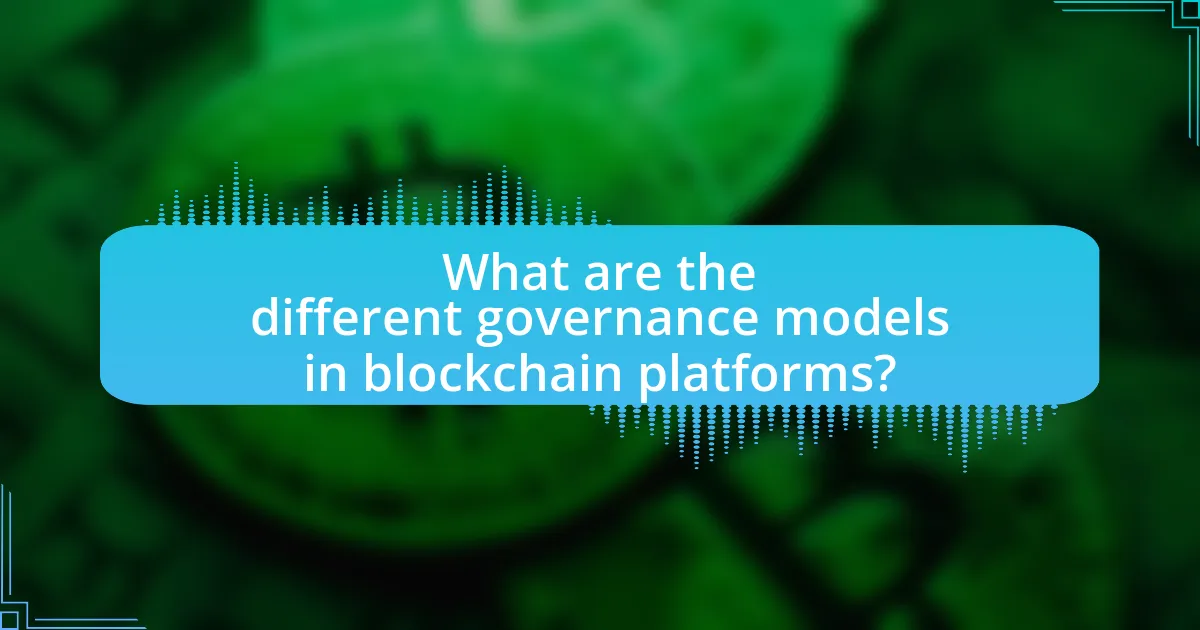
What are the different governance models in blockchain platforms?
The different governance models in blockchain platforms include on-chain governance, off-chain governance, and hybrid governance. On-chain governance allows stakeholders to vote on protocol changes directly through the blockchain, exemplified by platforms like Tezos, where governance decisions are made via formal voting mechanisms. Off-chain governance relies on community discussions and external consensus, as seen in Bitcoin, where changes are proposed and debated outside the blockchain before implementation. Hybrid governance combines elements of both on-chain and off-chain models, allowing for flexibility and community engagement, as demonstrated by platforms like Ethereum, which utilizes off-chain discussions for proposals while implementing on-chain voting for certain decisions. These models reflect varying degrees of decentralization and community involvement in decision-making processes.
How do governance models influence decision-making in blockchain?
Governance models significantly influence decision-making in blockchain by determining how stakeholders participate in protocol changes and resource allocation. For instance, in decentralized governance models like those used by Ethereum, decisions are made through community consensus, allowing token holders to vote on proposals, which fosters inclusivity and adaptability. In contrast, centralized governance models, such as those seen in Ripple, concentrate decision-making power within a small group, leading to quicker but potentially less democratic outcomes. The impact of these governance structures is evident in the varying levels of community engagement and responsiveness to issues, as seen in the contrasting approaches of Ethereum and Ripple, where Ethereum’s model has led to a more dynamic ecosystem capable of rapid innovation compared to Ripple’s more stable but less flexible framework.
What are the key components of governance models in blockchain?
The key components of governance models in blockchain include consensus mechanisms, decision-making processes, stakeholder participation, and protocol upgrades. Consensus mechanisms, such as Proof of Work or Proof of Stake, determine how transactions are validated and agreed upon within the network. Decision-making processes outline how changes to the protocol are proposed, debated, and implemented, often involving on-chain or off-chain voting systems. Stakeholder participation ensures that various parties, including developers, miners, and users, have a voice in governance, which can influence the direction of the blockchain. Protocol upgrades refer to the methods by which the blockchain can evolve, including hard forks or soft forks, which require community consensus to implement changes. These components collectively shape how a blockchain operates and adapts over time.
How do governance models affect community participation?
Governance models significantly influence community participation by determining how decisions are made and who has the authority to make them. For instance, decentralized governance models, such as those used in blockchain platforms like Ethereum, empower community members to propose and vote on changes, fostering higher engagement and inclusivity. In contrast, centralized governance models, like those seen in traditional organizations, often limit participation to a select group of individuals, which can lead to disengagement among the broader community. Research indicates that platforms with decentralized governance structures tend to have higher levels of active participation, as evidenced by Ethereum’s governance mechanisms, which allow for community-driven proposals and voting, resulting in a more vibrant and involved user base.
What are the primary types of governance models used in leading blockchain platforms?
The primary types of governance models used in leading blockchain platforms include on-chain governance, off-chain governance, and hybrid governance. On-chain governance allows stakeholders to vote on protocol changes directly through the blockchain, as seen in platforms like Tezos, where governance proposals are submitted and voted on by token holders. Off-chain governance involves decision-making processes that occur outside the blockchain, often through community discussions and forums, exemplified by Bitcoin, where changes are proposed and debated in developer communities before implementation. Hybrid governance combines elements of both on-chain and off-chain models, allowing for flexibility and community engagement, as demonstrated by Ethereum, which utilizes off-chain discussions for proposals while implementing on-chain voting for certain decisions. These governance models reflect the diverse approaches blockchain platforms take to manage protocol changes and community involvement.
What is on-chain governance and how does it function?
On-chain governance is a mechanism that allows stakeholders in a blockchain network to participate in decision-making processes directly on the blockchain itself. This governance model functions through proposals that can be submitted by any participant, which are then voted on by token holders or stakeholders, with the outcomes recorded immutably on the blockchain. For example, platforms like Tezos and Decred utilize on-chain governance to enable protocol upgrades and changes, ensuring that all stakeholders have a voice in the evolution of the network. This method enhances transparency and accountability, as all decisions and voting results are publicly accessible and verifiable on the blockchain.
What is off-chain governance and what are its implications?
Off-chain governance refers to decision-making processes that occur outside the blockchain network, allowing stakeholders to influence protocol changes without requiring on-chain consensus. This model enables faster and more flexible governance, as it can incorporate diverse stakeholder opinions and adapt to changing circumstances without the limitations of on-chain voting mechanisms. For instance, platforms like Tezos utilize off-chain governance to facilitate protocol upgrades through community discussions and proposals, which can be executed more swiftly than on-chain methods. The implications of off-chain governance include increased adaptability and responsiveness to community needs, but it may also lead to centralization risks if a small group of stakeholders dominates decision-making processes.
How do hybrid governance models operate in blockchain ecosystems?
Hybrid governance models in blockchain ecosystems operate by combining elements of both centralized and decentralized governance structures. These models leverage the efficiency and decision-making speed of centralized systems while incorporating the transparency and community involvement characteristic of decentralized systems. For instance, a hybrid model may allow a core team to make rapid decisions on technical upgrades, while simultaneously enabling token holders to vote on significant protocol changes, thus balancing control and community input. This approach is evident in platforms like Tezos, where on-chain governance allows stakeholders to propose and vote on amendments, ensuring adaptability while maintaining a degree of centralized oversight.

How do leading blockchain platforms compare in their governance approaches?
Leading blockchain platforms exhibit diverse governance approaches, primarily categorized into on-chain and off-chain governance. For instance, Ethereum employs a mixed governance model where protocol changes are proposed through Ethereum Improvement Proposals (EIPs) and community consensus, while Bitcoin relies on a more decentralized, informal process where miners and developers influence decisions without formal voting mechanisms.
In contrast, platforms like Tezos utilize on-chain governance, allowing stakeholders to vote directly on protocol upgrades, which facilitates a more structured decision-making process. Similarly, Cardano implements a treasury system where community members can propose and vote on projects, enhancing participatory governance.
These differences highlight how governance structures impact decision-making speed, community involvement, and adaptability to changes, with on-chain models generally promoting quicker consensus and off-chain models emphasizing decentralization and security.
What governance model does Bitcoin utilize and why?
Bitcoin utilizes a decentralized governance model, which is primarily based on consensus mechanisms and community-driven decision-making. This model allows all participants in the network to have a say in protocol changes through a process that involves Bitcoin Improvement Proposals (BIPs) and community discussions. The decentralized nature ensures that no single entity has control over the network, promoting security and resistance to censorship. The effectiveness of this governance model is evidenced by Bitcoin’s resilience and stability since its inception in 2009, despite numerous challenges and proposed changes.
How does Bitcoin’s governance model impact its scalability and security?
Bitcoin’s governance model, characterized by a decentralized consensus mechanism and reliance on community consensus for protocol changes, significantly impacts its scalability and security. The model prioritizes security through a robust proof-of-work system, which requires substantial computational power to validate transactions, thereby deterring malicious attacks. However, this same model limits scalability, as the need for widespread agreement among participants can slow down the implementation of necessary upgrades, such as increasing block size or modifying transaction throughput. For instance, the block size debate highlighted how governance decisions can lead to forks, as seen with Bitcoin Cash, which split from Bitcoin to address scalability concerns. This illustrates that while Bitcoin’s governance model enhances security through decentralization, it simultaneously poses challenges to scalability due to the complexities of reaching consensus among a diverse stakeholder group.
What challenges does Bitcoin face with its governance model?
Bitcoin faces significant challenges with its governance model, primarily due to its decentralized nature and lack of formal leadership. This decentralization leads to difficulties in decision-making, as there is no single authority to implement changes or resolve disputes. Additionally, the governance model is often criticized for being slow to adapt to necessary updates, such as scalability improvements, which can hinder its competitiveness against other blockchain platforms. Historical instances, such as the contentious debates over the block size limit, illustrate how disagreements among stakeholders can lead to forks, further complicating governance. These factors collectively contribute to Bitcoin’s ongoing governance challenges.
What governance strategies are employed by Ethereum?
Ethereum employs a combination of on-chain and off-chain governance strategies. On-chain governance includes mechanisms such as Ethereum Improvement Proposals (EIPs), which allow developers and community members to propose changes or upgrades to the protocol. These proposals undergo a review process and require consensus from the community to be implemented. Off-chain governance involves discussions and decision-making processes that occur in forums, social media, and community meetings, where stakeholders can express their opinions and influence decisions. This dual approach allows Ethereum to adapt and evolve while considering the diverse perspectives of its community members.
How does Ethereum’s transition to proof-of-stake affect its governance?
Ethereum’s transition to proof-of-stake (PoS) enhances its governance by decentralizing decision-making and increasing stakeholder participation. In PoS, validators are chosen based on the amount of cryptocurrency they hold and are willing to “stake,” which incentivizes a broader range of participants to engage in governance processes. This shift allows for more diverse input in protocol upgrades and changes, as opposed to the previous proof-of-work model, where mining power concentrated decision-making among a few large entities. The Ethereum Foundation and community now have a more inclusive governance structure, as seen in the implementation of the Ethereum Improvement Proposal (EIP) process, which allows stakeholders to propose and vote on changes, reflecting a more democratic approach to governance.
What role does the Ethereum Improvement Proposal (EIP) process play in governance?
The Ethereum Improvement Proposal (EIP) process serves as a structured mechanism for proposing changes and enhancements to the Ethereum network, thereby playing a crucial role in its governance. This process allows developers and community members to submit proposals that can be discussed, reviewed, and potentially implemented, ensuring that governance is community-driven and transparent. For instance, EIPs like EIP-1559, which introduced a new fee structure, were subject to extensive community debate and ultimately led to significant changes in how transactions are processed on the Ethereum blockchain. This collaborative approach fosters inclusivity and allows for diverse input, which is essential for the evolution of the network.
How does the governance model of Cardano differ from others?
The governance model of Cardano differs from others primarily through its use of a decentralized treasury system and a formal voting mechanism that empowers stakeholders. Cardano employs a unique approach called Project Catalyst, which allows ADA holders to propose and vote on funding for projects, ensuring that the community has a direct say in the development and direction of the platform. This model contrasts with many other blockchain platforms that may rely on centralized decision-making or informal consensus processes. Additionally, Cardano’s governance is built on a scientific philosophy, incorporating peer-reviewed research and formal methods to enhance security and reliability, which is not commonly found in other blockchain governance frameworks.
What unique features does Cardano’s governance model offer?
Cardano’s governance model offers unique features such as a decentralized voting system and a treasury management mechanism. The decentralized voting system allows ADA holders to participate in decision-making processes regarding protocol upgrades and funding proposals, ensuring that governance is community-driven. Additionally, the treasury management mechanism allocates funds for development and community projects based on community votes, promoting transparency and accountability. These features are designed to enhance user participation and ensure that the network evolves according to the collective interests of its stakeholders.
How does Cardano ensure community involvement in its governance?
Cardano ensures community involvement in its governance through a structured framework that includes a decentralized voting system and community engagement initiatives. The platform utilizes a treasury system where community members can propose and vote on projects, thereby directly influencing the allocation of funds and development priorities. This participatory approach is facilitated by the Project Catalyst initiative, which allows users to submit proposals and vote on them using the native ADA token. As of 2023, over 1,000 projects have been funded through this mechanism, demonstrating active community participation and decision-making power in the governance process.
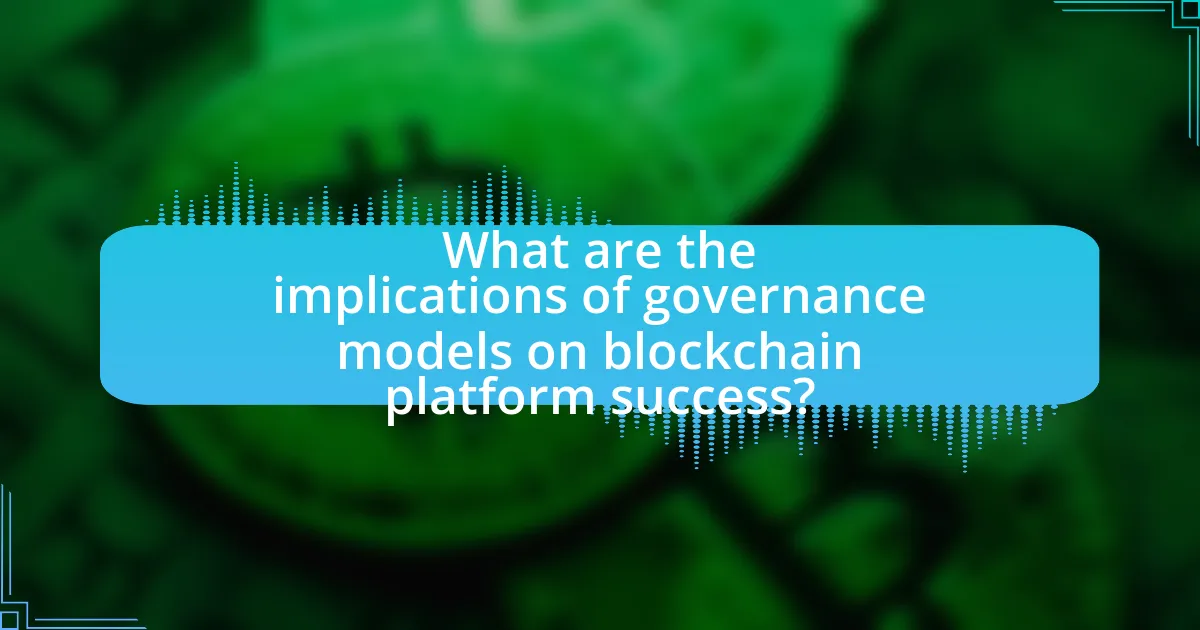
What are the implications of governance models on blockchain platform success?
Governance models significantly impact the success of blockchain platforms by influencing decision-making processes, stakeholder engagement, and adaptability to change. Effective governance structures, such as decentralized autonomous organizations (DAOs) or on-chain voting mechanisms, enhance transparency and trust among users, which are critical for user adoption and network growth. For instance, platforms like Ethereum utilize a community-driven governance model that allows stakeholders to propose and vote on protocol changes, fostering a sense of ownership and participation. Research indicates that platforms with robust governance frameworks, such as Tezos, which employs on-chain governance, experience higher levels of community involvement and quicker adaptation to technological advancements. This correlation between governance models and platform success underscores the necessity for well-defined governance strategies to ensure long-term viability and competitiveness in the blockchain ecosystem.
How do governance models impact the adoption of blockchain technologies?
Governance models significantly impact the adoption of blockchain technologies by influencing decision-making processes, stakeholder engagement, and regulatory compliance. For instance, decentralized governance models, such as those used by Ethereum, promote community participation and transparency, which can enhance trust and encourage wider adoption. In contrast, centralized governance models, like those seen in some enterprise blockchains, may streamline decision-making but can limit user participation and create barriers to entry. Research indicates that platforms with inclusive governance structures tend to experience higher levels of user engagement and innovation, as evidenced by the success of projects like Tezos, which incorporates on-chain governance to adapt and evolve based on community feedback.
What role does transparency play in the effectiveness of governance models?
Transparency is crucial for the effectiveness of governance models as it fosters trust and accountability among stakeholders. In governance frameworks, particularly in blockchain platforms, transparency ensures that all actions and decisions are visible and verifiable, which mitigates the risk of corruption and enhances stakeholder engagement. For instance, studies have shown that blockchain’s inherent transparency features, such as public ledgers, allow participants to independently verify transactions and governance decisions, leading to increased confidence in the system. This is evidenced by the success of platforms like Ethereum, where transparent governance mechanisms have facilitated community participation and decision-making processes, ultimately contributing to the platform’s resilience and adaptability.
How can governance models affect the longevity of a blockchain platform?
Governance models significantly influence the longevity of a blockchain platform by determining how decisions are made, how conflicts are resolved, and how the platform adapts to changes. Effective governance models, such as those that incorporate decentralized decision-making and community participation, can enhance user trust and engagement, leading to sustained platform usage. For instance, platforms like Ethereum utilize a combination of on-chain and off-chain governance, allowing for flexibility and responsiveness to community needs, which has contributed to its ongoing development and user retention. In contrast, platforms with rigid governance structures may struggle to adapt, resulting in decreased user interest and potential obsolescence. Historical examples, such as the governance challenges faced by Bitcoin Cash, illustrate how ineffective governance can lead to forks and fragmentation, ultimately impacting the platform’s longevity.
What best practices can be derived from analyzing governance models?
Best practices derived from analyzing governance models include establishing clear decision-making processes, ensuring stakeholder participation, and implementing transparent communication channels. Clear decision-making processes, such as defined voting mechanisms, enhance efficiency and accountability, as seen in platforms like Ethereum, which utilizes a proposal system for community input. Stakeholder participation is crucial; for instance, Tezos incorporates a self-amending governance model that allows token holders to vote on protocol upgrades, fostering inclusivity. Transparent communication channels, exemplified by Polkadot’s open forums for discussions, build trust and facilitate informed decision-making among participants. These practices contribute to more robust and adaptable governance structures in blockchain ecosystems.
How can blockchain platforms improve their governance structures?
Blockchain platforms can improve their governance structures by implementing decentralized decision-making processes that enhance transparency and stakeholder participation. By utilizing mechanisms such as on-chain voting and consensus algorithms, platforms can ensure that all stakeholders have a voice in governance decisions, thereby increasing trust and accountability. For instance, platforms like Tezos and DAOstack have successfully integrated decentralized governance models that allow token holders to propose and vote on protocol changes, demonstrating the effectiveness of such approaches in fostering community engagement and adaptability.
What lessons can new blockchain projects learn from established governance models?
New blockchain projects can learn the importance of clear decision-making processes from established governance models. For instance, successful governance frameworks like those of Ethereum and Tezos emphasize the need for transparent voting mechanisms and stakeholder engagement, which enhance community trust and participation. Research shows that Ethereum’s governance model, which includes off-chain discussions and on-chain voting, has led to more informed decisions and adaptability in protocol upgrades. By adopting similar structured approaches, new projects can mitigate conflicts and foster a collaborative environment, ultimately leading to more sustainable development and user satisfaction.












